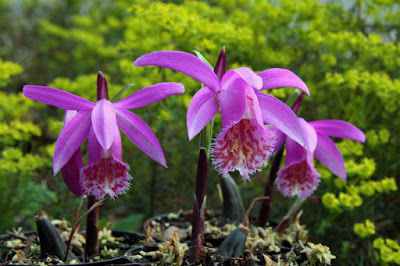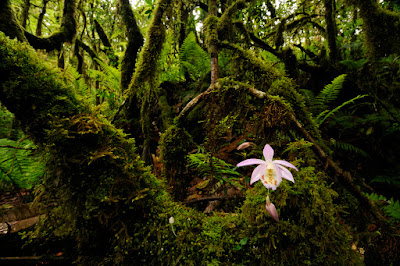Pleione orchid is distributed in the mountains and foothills of the Himalayas, India, Tibet, Nepal, Bhutan, Bangladesh, Burma, Thailand, Laos, Vietnam, Taiwan, and China. They grow in a wide range of conditions, from almost bare branches of forest trees, mossy limbs, fallen rotting logs, moss covered rocks, soil filled pockets on cliff faces and occasionally on grassland at altitudes of 600–4200 meters.
Pleione orchid also called as Glory of the east, Himalayan crocus, Indian crocus, Windowsill orchid, Gomphostylis, is a genus of the Orchidaceae family. This species was described by David Don in 1825.
IDENTIFY PLEIONE ORCHID PLANT
Pleione orchid is distributed in the mountains and foothills of the Himalayas, India, Tibet, Nepal, Bhutan, Bangladesh, Burma, Thailand, Laos, Vietnam, Taiwan, and China. They grow in a wide range of conditions, from almost bare branches of forest trees, mossy limbs, fallen rotting logs, moss covered rocks, soil filled pockets on cliff faces and occasionally on grassland at altitudes of 600–4200 meters.
Windowsill orchid are terrestrial but sometimes epiphytic or lithophytic, miniature orchids and have an annual life cycle. They overwinter as dormant bulbs, flower in spring, grow leaves and roots and new bulbs during summer and shed leaves in autumn. Their pseudobulbs only live for one year, producing 2 or 3 new bulbs before they die. Some species from warmer climates such as Pleione praecox, flower in autumn after the leaves wither. Pleione go dormant in winter when the leaves die off and the old pseudobulb withers. Each bulb can produce up to 3 flowers.
The flowers are similar among the species. Sepals and petals are alike in shape and color, with the sepals a little broader. The lip is the largest and showiest floral segment and is often three lobed. There is a distinct callus on the lip which helps in identifying species. The margin of the lip may be entire or fringed.
There are about 21 species, 5 natural hybrids and many hybrids have been created with Pleione formosana as a parent. Commonly grown hybrids are Pleione Tongariro, Pleione Versailles (formosana x limprichtii) and Pleione Shantung (formosana x confusa) and Pleione Eiger (formosana x humilis). The latter hybrid multiplies quickly and produces very large bulbs.
PLEIONE ORCHID PLANT CARE AND CULTURE
Cultural information should only be used as a guide, and should be to be adapted to suit you. Your physical location; where you grow your plants, how much time you have to devote to their care, and many other factors, will need to be taken into account. Only then can you decide on the cultural methods that best suit you and your plants.
Light:
Temperature:
The average temperature in summer in their natural environment typically does not exceed 25°C. Their preferred temperature range is 25°C in summer and 1-5°C in winter. However they will tolerate higher summer temperatures of 35°C for short periods. They need cool to cold temperatures in winter of between 1 and 5°C. Some references state they are frost tolerant but it would be prudent to protect them from frost. Plants may die if temperatures fall below 0°C.
A few species and hybrids such as Pleione maculata, Pleione praecox and the hybrid Pleione lagenaria have a much shorter dormant period and flower in autumn and winter. These should be kept warmer with a minimum of 10°C and are more susceptible to frost. Some species such as Pleione coronaria, Pleione scopulorum, Pleione forrestii and Pleione hookeriana have a longer cold dormant period in winter and can be kept in the fridge if necessary.
Humidity:
Windowsill orchid like good air movement. Place them near the bottom of the shade house where it is coolest and humidity highest. Misting is beneficial in very hot weather.
Substrate, growing media and repotting:
Pleione orchid are shallow rooting and grow best in squat pots. They require a free draining open potting mix. Small sized bark mixed with perlite in a 3:1 ratio is a suitable mix. Some growers use sphagnum moss instead of perlite but this can become soggy and perlite is considered a better option.
Glory of the east should be repotted when they are dormant in winter, except for the winter flowering types that are best done after flowering. Their roots die at the end of the season. When repotting remove all the roots leaving about 3 cm of roots to anchor the pseudobulb in the compost. Last years old pseudobulb shrivels to leave 1 to 3 new pseudobulbs. The old pseudobulbs can be discarded. The bulbs can be stored for 1 or 2 months providing they are kept cool and dry in a paper bag.
Pseudobulbs should be repotted annually. The new pseudobulbs should be buried with one third above the compost. The bulbs can be placed slightly deeper than shown in the photograph opposite. They are best placed sitting on the potting mix and then additional potting mix added to leave just one third of the bulb showing. Bulbs should be planted about 2cm apart as they grow better when planted close. Keep pots in a cold place (1-10°C) and don’t water until flower buds appear then very sparingly until leaves are well developed.
Watering:
Windowsill orchid should be watered regularly through the warmer months but totally dry in winter. Water in the early morning and not during the heat of the day. Roots start to grow as the flowers die and only a little water should be given from this time on as they have yet to develop roots. Keeping them drier at the start of the growing season also encourages the roots to penetrate. Over watering during the early root growth stage is a major cause of plant loss. Once leaves are well developed they can be watered freely. Stop watering when the leaves go yellow and allow them to become completely dry. They will not tolerate being cold (0-10°C) and wet at the same time. Pleione saxicola is an exception and this autumn flowering species must be kept moist all year round.
Fertilizer:
Pleione orchid like regular but weak liquid fertilizer during their growing period (October to April) but not when they are dormant. Use a lower N fertiliser at the end of summer to encourage flower bud development.
BUY PLEIONE ORCHID PLANT AND RELATED PRODUCTS
SOME SPECIES AND VARIETIES OF PLEIONE ORCHID WITH CULTURE SHEET AND CARE TIPS:
- Pleione albiflora - The White Flowered Pleione
- Pleione aurita - The Golden Pleione
- Pleione bulbocodioides - The Bulbocodium-Like Pleione
- Pleione chunii - Chun's Pleione
- Pleione coronaria - The Wreath-Shaped Pleione
- Pleione formosana - The Formosa Pleione - Taiwan Pleione - Windowsill Orchid
- Pleione forrestii - Forrest's Pleione
- Pleione grandiflora - The Large Flowered Pleione
- Pleione hookeriana - Hooker's Pleione
- Pleione humilis - The Low Growing Pleione
- Pleione limprichtii - Hardy Chinese Orchid - Limpritch's Pleione
- Pleione maculata - The Spotted Pleione
- Pleione pleionoides - The Pleione-like Pleione
- Pleione praecox - The Early Blooming Pleione
- Pleione saxicola - The Lithophytic Pleione
- Pleione scopulorum - The Branching Pleione
- Pleione yunnanensis - The Yunnan Pleione















excellent post
ReplyDelete